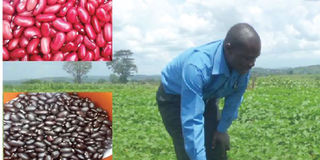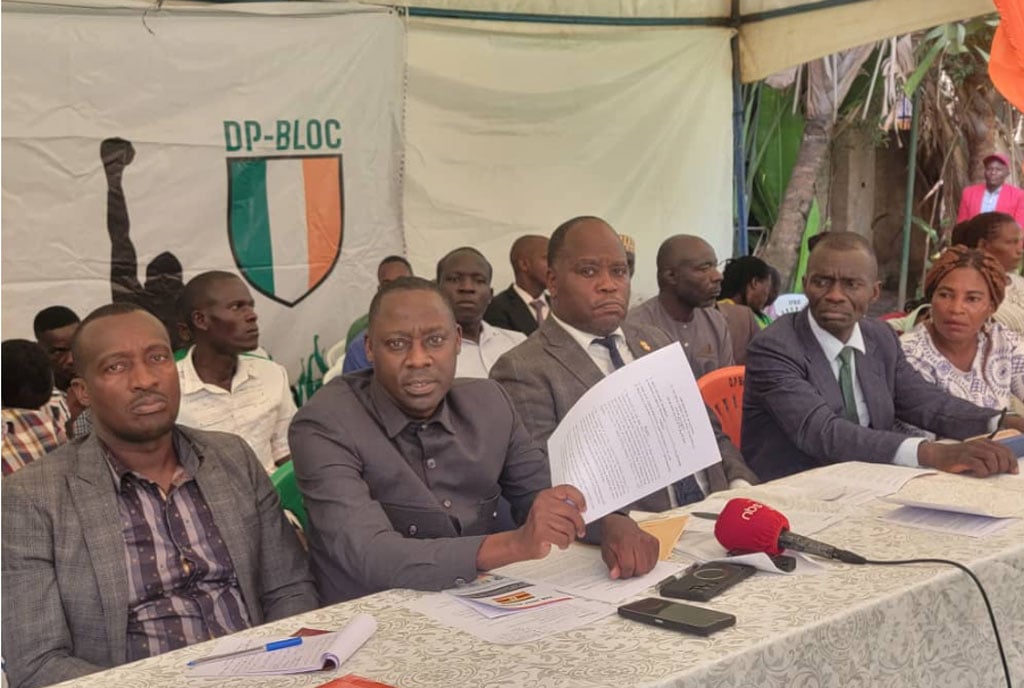Prime
New hybrid beans set to double farmers’ income

Breeder at Naro check the hybrid beans at the demonstration farm. Inset are the black and red small beans which are resistant to pests and diseases. The scientists have released new breeds of beans which are tolerant to draught. Photo by Lominda Afedraru
What you need to know:
- Farmers can grow beans on both fertile smooth and rough seed beds. However, when you grow beans on smooth soils, you should be cautious enough to avoid soil erosion, writes Lominda Afedraru.
Bush beans are one of the crops that nearly every farmer in Uganda and across Africa is growing.
For farmers planting beans considering the short maturity span means food on the table and this makes it a good choice for succession planting.
Unlike the climbing beans, they do not need trellises and they have the advantage of adding nitrogen in the soil thereby causing fertility.
Scientists handling bean breeding at the National Crop Resources Research Institute (NaCRRI) in Namulonge have over the years released a series of varieties, namely Nambale, K131 (1994), K132 (1994), NABE 2 (1995), NABE 3, NABE 4 and NABE 5 with the recent Narobean varieties 1,2,3 bush type and 4C and 5C climbing beans with Iron and Zinc nutrient.
Previous climbing bean varieties include NABE series 7C, 8C, 9C, 10C and NABE 12 released in 2003.
However the recently released varieties by the Ministry of Agriculture include NAROBEAN 6 and NAROBEAN 7 which are small seeded varieties that not only have better strength to withstand heat stress, but are also high yielding and early maturing. The breeding process started in 2011.
Seeds of Gold interviewed the head of bean breeding at NaCRRI, Dr Stanley Nkalubo, about the subject matter and below are excerpts.
Addressing the challenge of climate change
He explained that the two varieties are meant to address prolonged drought, a challenge farmers are faced with across the country.
“Prolonged drought is very prominent, especially in the central, mid-eastern, mid - western, south-western, eastern and northern semi-arid areas of Uganda, leading to serious bean yield losses and as bean breeders we set out to develop varieties that yield potentially well in the intermittent drought stressed environment,” he noted.
The varieties are meant for farmers to cope with the changing conditions of climate to enable farmers grow these varieties during periods when there is heat stress.
Previously, farmers used to plant in February and harvest between mid-May and June.
The story drastically changed from as far back as 2016 where the season faltered and farmers experienced plants in the fields drying from excessive heat.
The reality of climate change has hit farmers where the country experienced little or no rainfall till late April leading to food availability hanging in the balance as most farmers have had to replant or forfeit their crop and wait for the next season.
With such fluctuating weather patterns, the release of the two drought tolerant bean varieties has come in handy.
The breeding process
While carrying out palatability tests in 10 different agro ecological zones across the country, the most preferred varieties were selected with focus on grain characteristics and marketability, cooking characteristics, consumer and farmer preferred traits.
The trials sites included the Abi Zonal Agricultural Research Development Institute (Abi Zardi) in Arua, Ngetta Zonal Agriculture Research Development Institute (ZARDI), Nakasongola, Nabuin Zardi in Nakapiripiti, BUZARDI in Hoima, Mbarara Zonal Agricultural Research and Development Institute (MbaZARDI), Mobuku in Kasese and the National Semi-Arid Resources Research Institute (NaSARRI) in Serere.
In the initial breeding process scientists identified 146 bean lines bred for drought tolerance which they evaluated for field adaptability from which eight genotypes were identified including SEN 98, SEN 99, SCR 26, SCN 1 and SCN 11. These, together with three drought sensitive varieties K132, NABE 4 and NABE 15, were screened for drought tolerance.
The scientists applied drought stress treatments 14 days after planting where well watered trial was irrigated daily throughout the growth cycle and those under heat the same way.
The two bush varieties were observed to resist heat conditions and also tolerant to most pests and diseases. They grow well in all-weather conditions but outperform other beans when subjected to heat stress.
Partners and stakeholders such as seed companies can now access seed for multiplication and for onward accessibility to farmers.
Attributes of the red seeded variety
The varieties are the category of red small seeded beans mainly grown by farmers in central and western Uganda and the attributes include drought tolerance and the yield potential is between 2,100 to 3,800 kilogrammes per hectare with maturity rate of 68-72 days. It contains Iron content of 70 ppm, Zinc 35 ppm and best suited for low-mid altitude area. It is highly palatable and tolerant to diseases such as anthracnose, BCMV, ALS, and rust.
Attributes of the black seeded variety
The black small seeded is grown by farmers in northern Uganda including West Nile. It is drought tolerant and the yield potential is 1,900 to 3,500 kilogrammes per hectare. It matures between 68 to 73 days and Iron rate is 75 ppm, Zinc 35 ppm.
It is best suited for low-mid altitude area and is highly palatable with people from northern Uganda consuming it most. It is tolerant to pests such as anthracnose, BCMV and Rust ALS.
Soils
Bush beans do not need a lot of soil preparation. The average soil is good enough to grow good beans. The seeds must push large cotyledons through the soil, so it should be loose and easily crumbled.
Farmers are advised to add humus such as aged manure, well-rotted leaf mold or organic compost. Plant the beans about four inches apart in all soils.
What your beans will need to grow
Farmers can grow beans on both fertile smooth and rough seed beds.
However, when you grow beans on smooth soils, you should be cautious enough to avoid soil erosion.
The beans will need optimal levels of nitrogen, phosphorus and potassium; these are major limiting factors for production.
How to manage weeds in your beans garden
Beans should be kept weed free, especially in the early stages of the crop growth. Farmers are advised to weed two to three weeks after showing.
Harvesting and drying
It is advisable for farmers to harvest the bean pods in the seventh or sixth week depending on the variety and date of planting.
The pods must be removed from the husks and dried at optimum temperatures.
They are advised to store the beans in air tight bags to prevent the development of weevil larvae that feed on the dried seed. The acceptable moisture content is 15 per cent but it is better to dry it lower.
How to plant your beans
Experts recommend that the depth of planting should not exceed 5cm to avoid seed germination failure when planted deep. Two to three seeds can be dropped in the hole.
The spacing is 50cm by10cm or 25cm by 20cm for bush types, and 50 cm by 15cm or 50cm by 20cm for climbing beans.




